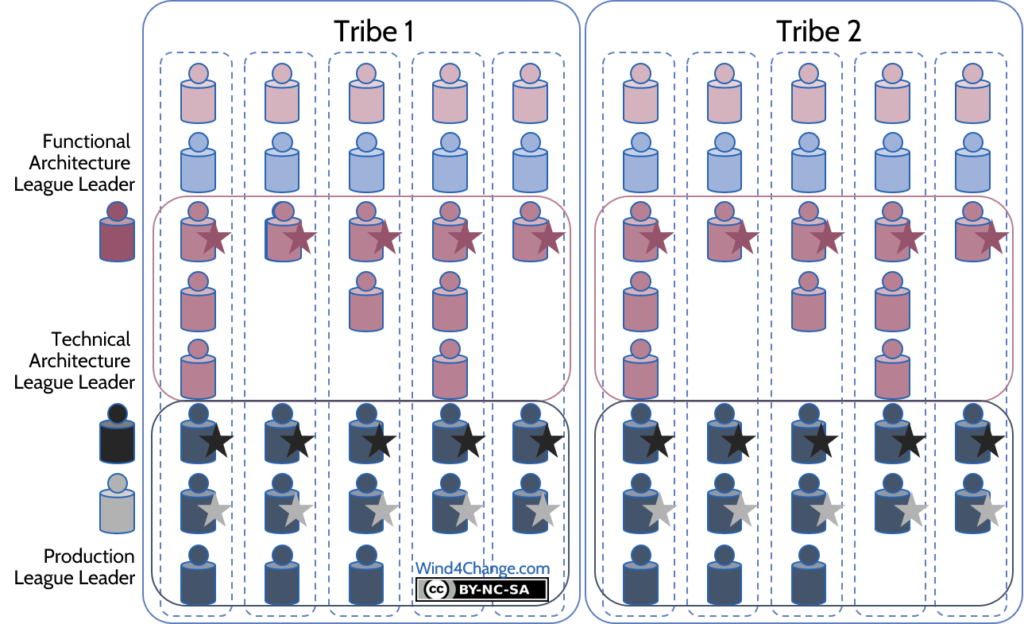What are the definition and the characteristics of a League in Agile at Scale? In addition, what are the differences with a Chapter or a Guild? At last, what is the the role of the League Manager and the League Members?
How to support production and architecture consistency across Tribes in Agile at Scale?
Transversal consistency is enforced in the Tribe thanks to the chapters. Nevertheless, there are some transversal topics cross-Tribe requiring additional mechanisms. This is the case for Production and Architecture either functional or technical. This is the mission of the Leagues.
Leagues are specific to this Return of Experience and are not part of the Spotify Model.

What is a League in Agile at Scale?
The purpose of Leagues like Chapters is to support knowledge sharing and consistency between its members.
But there are several differences:
- A League is cross-Tribe and covers topics that are beyond the responsibility of a Tribe
- They cover, in this Return of Experience, only the following topics:
- Production guidelines and best practices
- Functional and Technical Architecture guidelines and best practices (2 different Leagues)
- Leagues are facilitated by League Leaders a role outside the Tribes from the Central Production organization and the Central Architecture organization
- A league is mandatory but not all Tribe Members are part of a League. Nevertheless, League Members will use their belonging Chapters and Agile Squads in order to share their knowledge to other Tribe Members and collect their feedback.
- The mission is more than sharing as they support the guidelines of the Leagues. Even if the Voice of the Field is taken into account to build those guidelines and the why of each guideline is explained with the what, once defined, those guidelines are mandatory to apply.
Further, what is the role of the League Leader ?
The role of the League Leader is to facilitate the League, have related members meet regularly and collaborate with them in order to:
- Build, update and share a vision and a strategy for the League
- Build, update and share guidelines and best practices for the League
- Support spreading the knowledge of the League outside the League through League Members: vision, strategy, guidelines and best practices
- Make sure that mechanisms are implemented in Tribes to support cascading of the League knowledge and to collect feedback from the field
At last, what is the role of the League Members ?
It is a difficult role as they act as intermediates between their League and their belonging Chapters and Agile Squads in order to:
- Collect field feedback around League area in order to build League knowledge
- Cascade League knowledge and collect related field feedback to adjust League knowledge and action
What’s next? Learn more about Agile at Scale
Check my other posts about Agile at Scale:
- Review my posts on Agile at Scale foundations:
- What are
- What are the team topologies?
- How to synchronize Agile Squads in Agile at Scale when there are dependencies?
- Check another of my posts introducing Agile at Scale that leverages the book “Doing Agile Right”.
- Review my post on the Agile best practices from the GAO the Government Accountability Office from the USA.
- Read my posts on advanced topics around Agile at Scale:
- What are Leagues in Agile at Scale?
- How to design Agile Squads so they are aligned on the Value Chains.
- Why going for horizontal management? What does it mean and what is the value?
- How roles are reallocated with Agile at Scale?
- Check my posts on project management in Agile at Scale
- What is the impact of Agile on Project Management?
- How does Project Portfolio Management change with Agile at Scale?
- Then, how does Cost of Delay Divided by Duration (CD3) contribute to Agile at Scale?
- How does Beyond Budgeting support Agile at Scale?
- Can an Agile Project be fixed price?
- How to manage Release Management in Agile?
- Review my posts on how to forge a good strategy:
- What are competition and competitive advantage?
- What is a good strategy?
